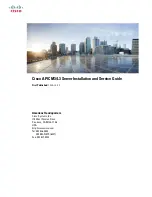
•
If memory modules with different speeds are installed, they will operate at the speed of the slowest installed memory module(s) or
slower depending on the system DIMM configuration.
•
Populate memory module sockets only if a processor is installed. For single-processor systems, sockets A1 to A10 are available. For
dual-processor systems, sockets A1 to A10 and sockets B1 to B6 are available.
•
Populate all the sockets with white release tabs first, followed by the black release tabs.
•
When mixing memory modules with different capacities, populate the sockets with memory modules with the highest capacity first.
For example, if you want to mix 8 GB and 16 GB memory modules, populate 16 GB memory modules in the sockets with white release
tabs and 8 GB memory modules in the sockets with black release tabs.
•
In a dual-processor configuration, the memory configuration for each processor should be identical. For example, if you populate
socket A1 for processor 1, then populate socket B1 for processor 2, and so on.
•
Memory modules of different capacities can be mixed provided other memory population rules are followed (for example, 8 GB and 16
GB memory modules can be mixed).
•
Mixing of more than two memory module capacities in a system is not supported.
•
Populate six memory modules per processor (one DIMM per channel) at a time to maximize performance.
Mode-specific guidelines
The configurations allowed depend on the memory mode selected in the System BIOS.
Table 7. Memory operating modes
Memory Operating Mode
Description
Optimizer Mode
(Default)
The
Optimizer Mode
if enabled, the DRAM controllers operate
independently in the 64-bit mode and provide optimized memory
performance.
Mirror Mode
The
Mirror Mode
if enabled, the system maintains two identical
copies of data in memory, and the total available system memory is
one half of the total installed physical memory. Half of the installed
memory is used to mirror the active memory modules. This feature
provides maximum reliability and enables the system to continue
running even during a catastrophic memory failure by switching
over to the mirrored copy. The installation guidelines to enable
Mirror Mode require that the memory modules be identical in size,
speed, and technology, and they must be populated in sets of 6 per
processor.
Single Rank Spare Mode
Single Rank Spare Mode
allocates one rank per channel as a
spare. If excessive correctable errors occur in a rank or channel,
while the operating system is running, they are moved to the spare
area to prevent errors from causing an uncorrectable failure.
Requires two or more ranks to be populated in each channel.
Multi Rank Spare Mode
Multi Rank Spare Mode
allocates two ranks per channel as a
spare. If excessive correctable errors occur in a rank or channel,
while the operating system is running, they are moved to the spare
area to prevent errors from causing an uncorrectable failure.
Requires three or more ranks to be populated in each channel.
With single rank memory sparing enabled, the system memory
available to the operating system is reduced by one rank per
channel.
For example, in a dual-processor configuration with sixteen 16 GB
dual-rank memory modules, the available system memory: 16 GB x
16(memory modules) - 8GB(1 rank sparing/channel) x 12(channel)
= 256 GB - 96 GB = 160 GB
For multi rank sparing, in a dual-processor configuration with
sixteen 64 GB quad-rank memory modules, the available system
memory: 64 GB x 16(memory modules) - 32 GB(2 rank sparing/
channel) x 12 (channel) = 1024 GB - 384 GB = 640 GB
NOTE:
To use memory sparing, this feature must be
enabled in the BIOS menu of System Setup.
Installing and removing system components
75
















































